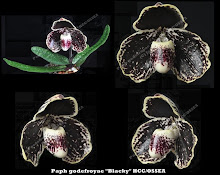
Display of Slipper Orchids.
 Phrag besseae:
Phrag besseae:A single well balanced and flat flower. The dorsal sepal and symmetrical petals are orange red. Pouch light yellow, veined dark orange between the windows.
A very well grown plant with several buds. This was the first time that this species was brought to the Monthly Table Display.
 Phrag Peruflora's Saltimbanco (Phrag kovachii x boisserianum):Phrag kovachii
Phrag Peruflora's Saltimbanco (Phrag kovachii x boisserianum):Phrag kovachii is about the most amazing orchid discovery of the last one hundred years. The horizontal spread can reach an amazing 20 cm across.
Several hybrids were made with
Phrag kovachii over the last few years and hopefully these hybrids would be much easier to cultivate. This hybrid was grown and exhibited by David Ng.
Single flower from 1 inflorescence with ruffled petals. The pouch, tessellated dorsal sepal and petals are light violet over the white base. This hybrid takes the colour of kovachii and the shape of
P. boisserianum. Phrag longifolium:
Phrag longifolium:Longifolium means "Long-Leaved". A variable species that are found in Central America.
Single flower with creamy green dorsal sepal, veined with maroon vertical stripes. Petals are apple green and veined on the fringe and underside of the petals. Large synsepal (in proportion to the DS) light cream and overlaid with vertical maroon stripes. Light green pouch and inner surface is speckled with spots.
 Paph vejvarutianum:
Paph vejvarutianum:An uncommon species that was described by Olaf Gruss in 2003. The are found in the eastern part of Thailand (Kanchanaburi). This species was in existence for many years in culture as
P. charlesworthii fma kanchanaburi until it was described in 2003 and elevated to the species level. This species is closely related too, and resembles barbigerum.
 Paph concolor var. longipetulum:
Paph concolor var. longipetulum:A species that is very widespread and can be found in Myanmar, Thailand, Cambodia, Loas, Vietnam, Yunnan Province and SW China. Plants can be found at elevation ranging from 90 to 1000 meters. They are found to be growing in bright, indirect sunlight with their roots in moss or leafy humus. A species that adapts well to our local weather.
This long and narrow petals with mid line maroon stripe variety is known as var. longipetulum. The sulphur yellow flower is finely spotted purple, both the petals are flexed backwards, nice proportional pouch that is lightly spotted on almost the entire pouch.
 Paph Susan Booth gx Nathaniel's Cilicia Group (Paph rothschildianum x praestans):
Paph Susan Booth gx Nathaniel's Cilicia Group (Paph rothschildianum x praestans):A very well grown hybrid which produces two inflorescences. Each spike carries two flowers. The plant was registered by Don late last year. The plant is exhibited by the registrant of this hybrid himself.
The creamy sepal is heavily striped mahogany, petals with prominent marginal black warts and mahogany pouch. The evenly twisted petals follow the parent of
P. praestans. The strong influence of the dark colour could have been from
P. gardinerii . P. gardinerii is one of the forms from the glanduliferum group. The others in the group are praestans and wilhelminae. If it was crossed with praestans, usually it is lighter colour, with wilhelminae it is even lighter. The original crossing of Paph Susan Booth made many years ago was very dark.
 Paph Bruno (Paph Leeanum x spicerianum):
Paph Bruno (Paph Leeanum x spicerianum):
A very old hybrid that was made in the 1890s. The cross is between Paph Leeanum (Paph insigne x spicerianum) and Paph spicerianum. A hybrid that could easily be passed on a Paph spicerianum as this progeny has 75% of spicerianum in it.
A very well grown specimen paph exhibited by Don with 5 flowers on 5 inflorescences borne on a 7-growth plant. Dorsal sepal is white with light green blotch at its base, light maroon at the mid line. Petals are yellow-green with light mahogany fading from the top towards the bottom of the pouch.
 Paph Muriel Constance:
Paph Muriel Constance:








